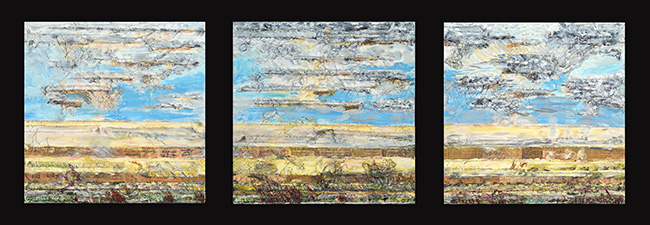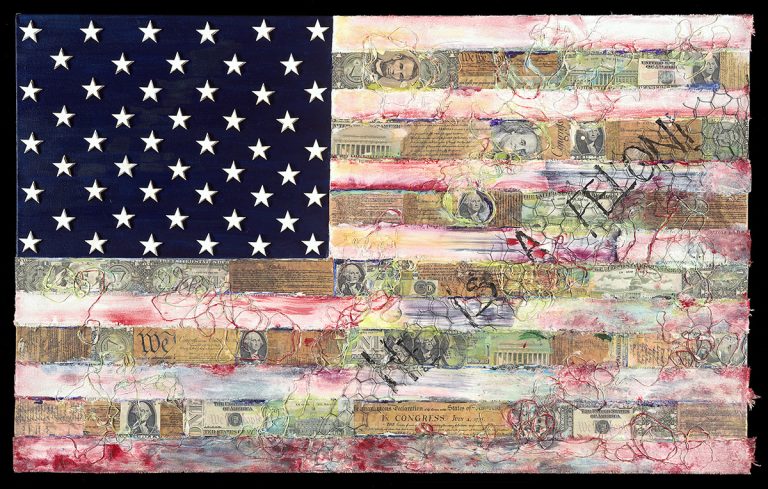L. Scooter Morris doesn’t create work that stays on the wall. It reaches out—visually, emotionally, and even physically. She calls herself a sensory illusionist, and it fits. Her “Sculpted Paintings” are built from mixed media and layered surfaces that invite you to move around them, not just look at them. These aren’t decorative pieces. They’re charged with tension—the kind that lives between what’s happening and what’s underneath.
What drives Morris isn’t perfection. It’s truth. She works to create spaces that ask, rather than answer—spaces where we can slow down, take stock, and ask harder questions about the world around us. She doesn’t offer slogans. Her work isn’t about clarity or comfort. It’s about complexity, contradiction, and choosing to look directly at what’s unfolding.

We Are The People (2025)
Acrylic and Mixed Media, 60” x 48”
This piece speaks to the weight of now. Using the U.S. founding documents not as inspiration but as raw material, Morris embeds them directly into the painting. The Constitution, the Declaration—they’re there in fragments, weathered and layered into the surface like something geological.
Rather than holding these texts up as sacred, she presents them as living material—fragile, flawed, powerful. Some lines are visible, others buried under paint and texture. It’s not a neat presentation because the ideas themselves aren’t neat. They’ve been revised, ignored, glorified, and torn apart.
At its core, this painting isn’t nostalgic—it’s a mirror. “We the People” isn’t a fixed identity. It’s something up for grabs. Morris uses this work to push the viewer into that uncertainty: What do those words mean now? Who belongs in that phrase, and who’s still waiting to be included?

Felon (2025)
Acrylic and Mixed Media, 30” x 48”
This work tells a more personal, more hidden story. Smaller in scale but dense in tone, Felon is about historical amnesia—the ways we rewrite, edit, and sometimes erase our past. Morris paints into that silence. She refers to it as a kind of confession, though not of guilt. It’s more like a peeling back of layers to show what’s usually left unsaid.
Hints of faces emerge through brushstrokes and textured overlays. Not portraits—more like suggestions of people and histories tucked into the background. Some may be admired leaders. Others, forgotten names. Morris isn’t interested in making heroes or villains. She’s interested in the messy middle.
There’s a haunted energy to the piece, but it’s not without grace. It’s reflective, even generous in how it lets contradiction stand. The painting invites the viewer to pause and ask what gets remembered and what gets left out—and who decides.

Time and Again (2025)
Acrylic and Mixed Media Triptych, 30” x 90”
In this triptych, Morris expands her inquiry into something bigger—more about pattern than moment. It’s wide, almost cinematic. The three panels feel like connected snapshots in a larger story of rise, fall, and persistence. Like in We Are The People, the founding documents are present. But here, they’re a kind of landscape—recurring, faded, reappearing.
There’s a sense of distance in the work, both physical and emotional. From afar, it might look like a horizon. But the closer you move in, the more layered it becomes—scratched surfaces, bits of text, uneven edges. The detail doesn’t resolve the piece. It complicates it.
Morris seems to be saying that we’ve been here before. That this cycle of struggle, hope, conflict, and reinvention is not new. The work doesn’t offer a roadmap. It holds the moment open long enough for us to sit with it.
Scooter Morris doesn’t push answers. She builds spaces for questions—questions about truth, power, history, and responsibility. Her art is layered both physically and conceptually. It’s not loud, but it doesn’t step back. It moves quietly and deliberately through themes that are too often flattened or ignored.
In her hands, paint becomes something to think with. And what she gives us, in the end, isn’t just something to see. It’s something to wrestle with.

